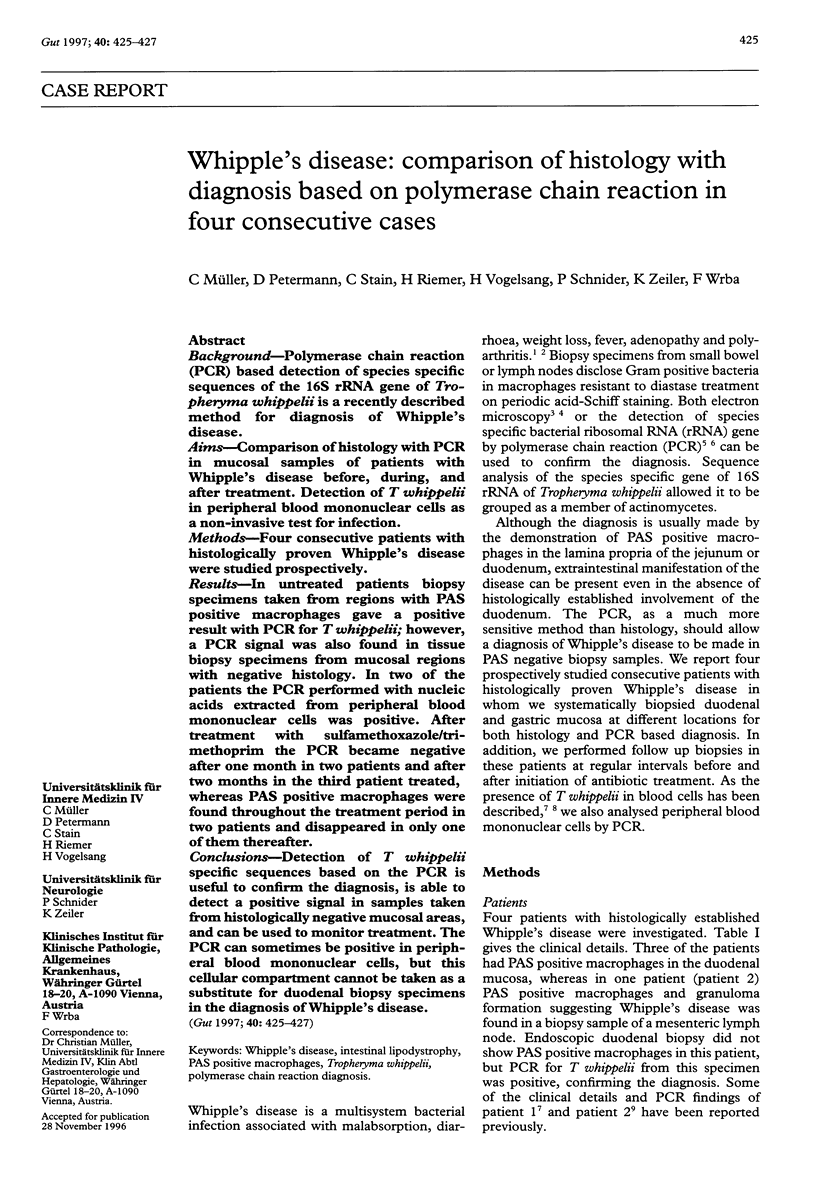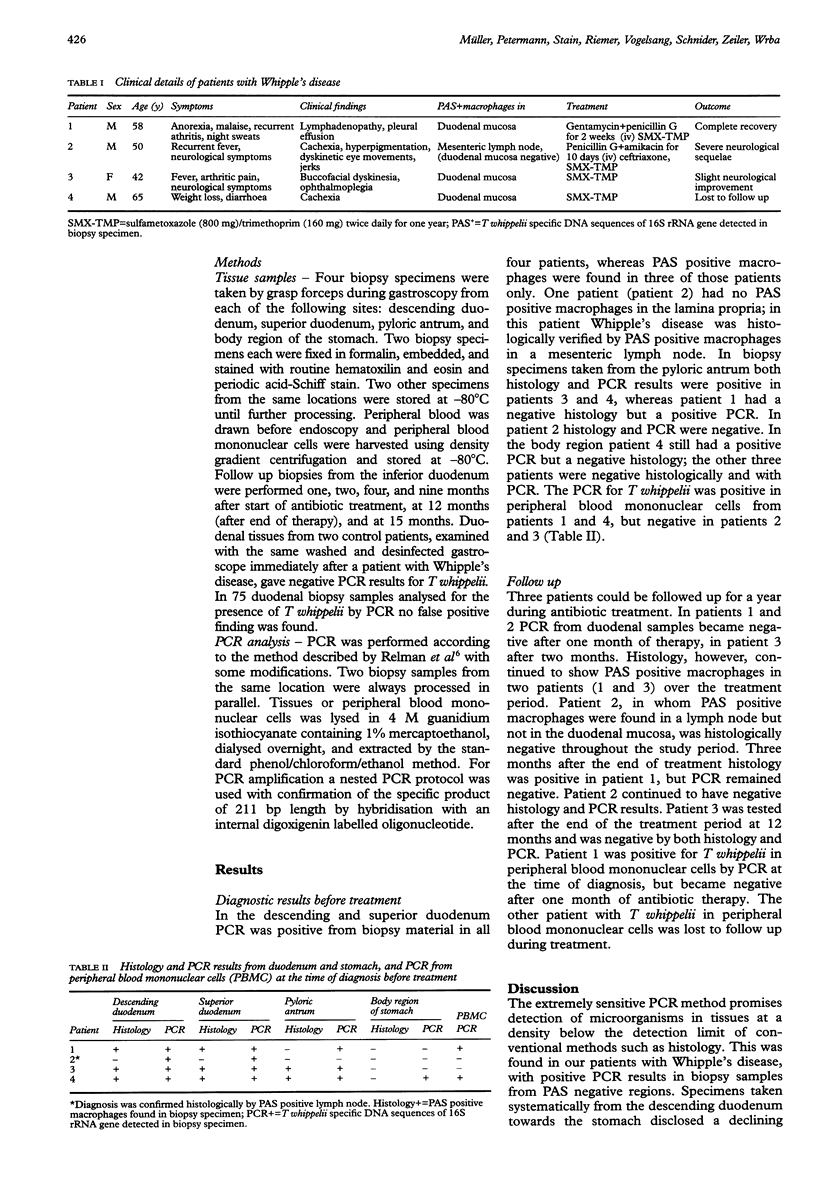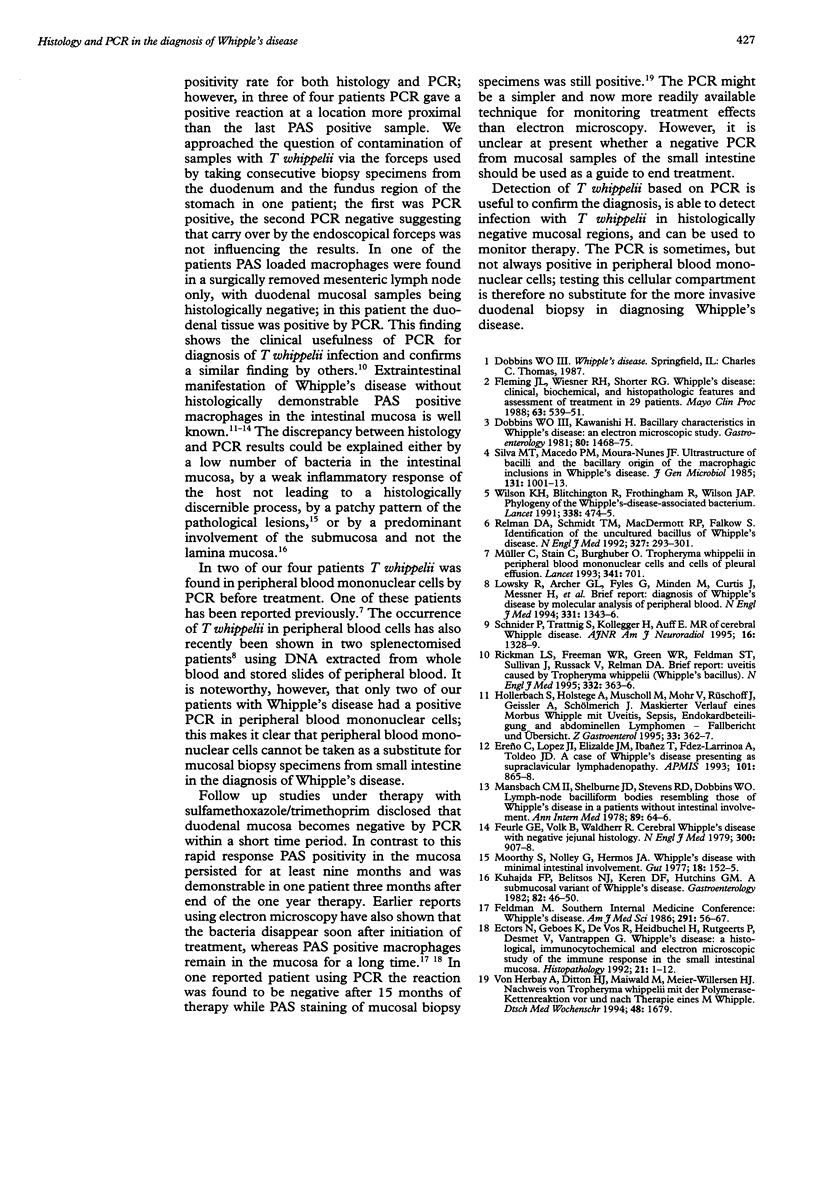Abstract
BACKGROUND: Polymerase chain reaction (PCR) based detection of species specific sequences of the 16S rRNA gene of Tropheryma whippelii is a recently described method for diagnosis of Whipple's disease. AIMS: Comparison of histology with PCR in mucosal samples of patients with Whipple's disease before, during, and after treatment. Detection of T whippelii in peripheral blood mononuclear cells as a non-invasive test for infection. METHODS: Four consecutive patients with histologically proven Whipple's disease were studied prospectively. RESULTS: In untreated patients biopsy specimens taken from regions with PAS positive macrophages gave a positive result with PCR for T whippelii; however, a PCR signal was also found in tissue biopsy specimens from mucosal regions with negative histology. In two of the patients the PCR performed with nucleic acids extracted from peripheral blood mononuclear cells was positive. After treatment with sulfamethoxazole/trimethoprim the PCR became negative after one month in two patients and after two months in the third patient treated, whereas PAS positive macrophages were found throughout the treatment period in two patients and disappeared in only one of them thereafter. CONCLUSIONS: Detection of T whippelii specific sequences based on the PCR is useful to confirm the diagnosis, is able to detect a positive signal in samples taken from histologically negative mucosal areas, and can be used to monitor treatment. The PCR can sometimes be positive in peripheral blood mononuclear cells, but this cellular compartment cannot be taken as a substitute for duodenal biopsy specimens in the diagnosis of Whipple's disease.
Full text
PDF


Selected References
These references are in PubMed. This may not be the complete list of references from this article.
- Dobbins W. O., 3rd, Kawanishi H. Bacillary characteristics in Whipple's disease: an electron microscopic study. Gastroenterology. 1981 Jun;80(6):1468–1475. [PubMed] [Google Scholar]
- Ectors N., Geboes K., De Vos R., Heidbuchel H., Rutgeerts P., Desmet V., Vantrappen G. Whipple's disease: a histological, immunocytochemical and electronmicroscopic study of the immune response in the small intestinal mucosa. Histopathology. 1992 Jul;21(1):1–12. doi: 10.1111/j.1365-2559.1992.tb00337.x. [DOI] [PubMed] [Google Scholar]
- Ereño C., Lopez J. I., Elizalde J. M., Ibañez T., Fernández-Larrinoa A., Toledo J. D. A case of Whipple's disease presenting as supraclavicular lymphadenopathy. A case report. APMIS. 1993 Nov;101(11):865–868. doi: 10.1111/j.1699-0463.1993.tb00193.x. [DOI] [PubMed] [Google Scholar]
- Feldman M. Whipple's disease. Am J Med Sci. 1986 Jan;291(1):56–67. doi: 10.1097/00000441-198601000-00011. [DOI] [PubMed] [Google Scholar]
- Feurle G. E., Volk B., Waldherr R. Cerebral Whipple's disease with negative jejunal histology. N Engl J Med. 1979 Apr 19;300(16):907–908. doi: 10.1056/NEJM197904193001607. [DOI] [PubMed] [Google Scholar]
- Fleming J. L., Wiesner R. H., Shorter R. G. Whipple's disease: clinical, biochemical, and histopathologic features and assessment of treatment in 29 patients. Mayo Clin Proc. 1988 Jun;63(6):539–551. doi: 10.1016/s0025-6196(12)64884-8. [DOI] [PubMed] [Google Scholar]
- Hollerbach S., Holstege A., Muscholl M., Mohr V., Rüschoff J., Geissler A., Schölmerich J. Maskierter Verlauf eines Morbus Whipple mit Uveitis, Sepsis, Endokardbeteiligung und abdominellen Lymphomen--Fallbericht und Ubersicht. Z Gastroenterol. 1995 Jul;33(6):362–367. [PubMed] [Google Scholar]
- Kuhajda F. P., Belitsos N. J., Keren D. F., Hutchins G. M. A submucosal variant of Whipple's disease. Gastroenterology. 1982 Jan;82(1):46–50. [PubMed] [Google Scholar]
- Lowsky R., Archer G. L., Fyles G., Minden M., Curtis J., Messner H., Atkins H., Patterson B., Willey B. M., McGeer A. Brief report: diagnosis of Whipple's disease by molecular analysis of peripheral blood. N Engl J Med. 1994 Nov 17;331(20):1343–1346. doi: 10.1056/NEJM199411173312004. [DOI] [PubMed] [Google Scholar]
- Mansbach C. M., 2nd, Shelburne J. D., Stevens R. D., Dobbins W. O., 3rd Lymph-node bacilliform bodies resembling those of Whipple's disease in a patient without intestinal involvement. Ann Intern Med. 1978 Jul;89(1):64–66. doi: 10.7326/0003-4819-89-1-64. [DOI] [PubMed] [Google Scholar]
- Moorthy S., Nolley G., Hermos J. A. Whipple's disease with minimal intestinal involvement. Gut. 1977 Feb;18(2):152–155. doi: 10.1136/gut.18.2.152. [DOI] [PMC free article] [PubMed] [Google Scholar]
- Müller C., Stain C., Burghuber O. Tropheryma whippelii in peripheral blood mononuclear cells and cells of pleural effusion. Lancet. 1993 Mar 13;341(8846):701–701. doi: 10.1016/0140-6736(93)90475-v. [DOI] [PubMed] [Google Scholar]
- Relman D. A., Schmidt T. M., MacDermott R. P., Falkow S. Identification of the uncultured bacillus of Whipple's disease. N Engl J Med. 1992 Jul 30;327(5):293–301. doi: 10.1056/NEJM199207303270501. [DOI] [PubMed] [Google Scholar]
- Rickman L. S., Freeman W. R., Green W. R., Feldman S. T., Sullivan J., Russack V., Relman D. A. Brief report: uveitis caused by Tropheryma whippelii (Whipple's bacillus) N Engl J Med. 1995 Feb 9;332(6):363–366. doi: 10.1056/NEJM199502093320604. [DOI] [PubMed] [Google Scholar]
- Schnider P., Trattnig S., Kollegger H., Auff E. MR of cerebral Whipple disease. AJNR Am J Neuroradiol. 1995 Jun-Jul;16(6):1328–1329. [PMC free article] [PubMed] [Google Scholar]
- Schnider P., Trattnig S., Kollegger H., Auff E. MR of cerebral Whipple disease. AJNR Am J Neuroradiol. 1995 Jun-Jul;16(6):1328–1329. [PMC free article] [PubMed] [Google Scholar]
- Silva M. T., Macedo P. M., Moura Nunes J. F. Ultrastructure of bacilli and the bacillary origin of the macrophagic inclusions in Whipple's disease. J Gen Microbiol. 1985 May;131(5):1001–1013. doi: 10.1099/00221287-131-5-1001. [DOI] [PubMed] [Google Scholar]
- Wilson K. H., Blitchington R., Frothingham R., Wilson J. A. Phylogeny of the Whipple's-disease-associated bacterium. Lancet. 1991 Aug 24;338(8765):474–475. doi: 10.1016/0140-6736(91)90545-z. [DOI] [PubMed] [Google Scholar]
- von Herbay A., Ditton H. J., Maiwald M., Meier-Willersen H. J. Nachweis von Tropheryma whippelii mit der Polymerase-Kettenreaktion vor und nach Therapie eines Morbus Whipple. Dtsch Med Wochenschr. 1994 Dec 2;119(48):1679–1679. [PubMed] [Google Scholar]


